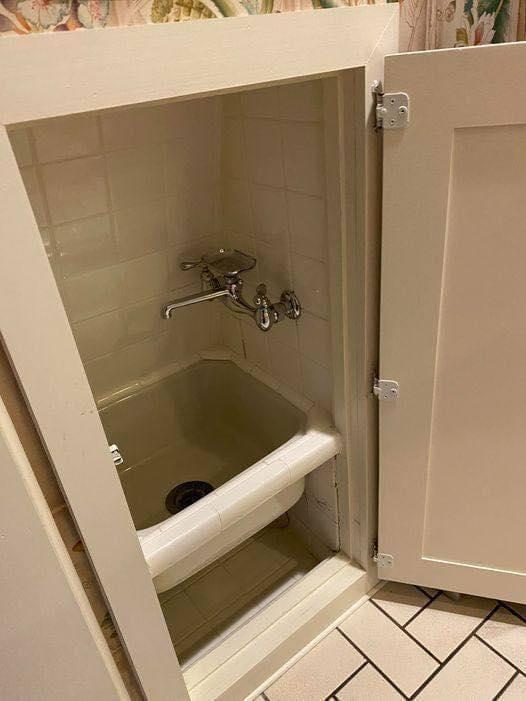When thinking of historical elements in homes, sinks might not be the first feature that comes to mind. However, sinks hold unique stories within their designs, functionalities, and materials, reflecting the social, practical, and aesthetic priorities of different eras. From the low-placed mopping sinks designed to ease daily chores to opulent bathroom sinks in mansions, each type offers insight into household norms and the evolution of domestic life.
The knee-level sink, for example, offers a fascinating look into the practical side of history. Commonly found in many historical households, these sinks were positioned at knee height to accommodate easy access for cleaning tasks without excessive bending. They made it easier to mop floors, wash rags, and rinse cleaning tools without the need for hauling heavy water buckets around the house. These sinks were typically installed in spaces away from main living areas, symbolizing a division between household chores and social spaces. Their presence highlights a time when domestic work was meticulously organized yet largely unseen.
Crafted primarily from stone or thick porcelain, knee-level sinks prioritized durability and simplicity. Yet, even in their utilitarian role, many of these sinks featured subtle decorative elements, like rounded edges or delicate grooves, showing that even the most practical household items were designed with an aesthetic touch. These materials were meant to endure years of use, reflecting both the craftsmanship and value placed on quality in an era before disposable culture.
The placement of these sinks within the household also speaks to the societal norms of the time. Placed in back corridors or near servant quarters, knee-level sinks were designed for household staff, marking a clear boundary between service areas and living spaces. This separation mirrored social hierarchies, where labor was often kept out of sight from guests and even some family members. Beyond convenience, it was a spatial arrangement that maintained household order and discretion.
As technology evolved, so did household design, and the once-essential knee-level sink became a rarity. Yet, vintage sinks, including these historical models, are now sought after for their charm, durability, and the nostalgic connection they offer to a bygone era. Renovators and designers today incorporate vintage sinks into modern homes, often in utility rooms, bathrooms, or garden areas where they add a touch of authenticity and style.
In a modern context, vintage sinks offer much more than practicality. For many homeowners, they embody a sense of resilience, artistry, and timeless design, creating a visual bridge between past and present. Restoring and repurposing a vintage sink involves more than just installation; it’s a conscious choice to blend history with modern aesthetics, respecting the craftsmanship of another era. Designers often pair these sinks with contemporary features, like polished metals or sleek tiles, balancing their rugged durability with modern finishes.
The appreciation for vintage sinks has grown alongside the rise of sustainable design. Choosing to restore and use an antique sink means valuing materials that have already stood the test of time, reducing the demand for new resources. This trend reflects a broader interest in sustainable choices, where quality items are preserved and repurposed rather than discarded. With their timeless appeal, vintage sinks fit seamlessly into this eco-conscious mindset, adding personality and history to homes while honoring sustainable principles.
Moreover, the appeal of vintage sinks is not just in their visual charm but in the stories they carry. Each scratch, stain, or worn edge hints at years of use, reminding us of past lives and hands that worked over them. For families with a historical bent or those simply looking for a unique statement piece, these sinks are more than just functional; they’re conversation starters that spark curiosity and admiration. It’s easy to see why more homeowners are drawn to these pieces, each one a small testament to the evolution of household design.
In the world of interior design, vintage sinks, especially unique types like knee-level mopping sinks, stand out as symbols of historical charm and craftsmanship. They are reminders of a time when utility items were built to last and were thoughtfully integrated into the household flow. These sinks, with their understated elegance, resonate with modern design philosophies that value simplicity, authenticity, and intentionality. For those with an eye for detail, a vintage sink can be the defining element that ties together a room, providing both practical use and a decorative focal point.
When considering a vintage sink for a modern home, it’s essential to weigh the functional needs of the space with the historical allure the sink brings. For many, this blend of old and new is precisely what makes these pieces so appealing. Imagine a laundry room with a knee-level sink; not only does it bring visual appeal, but it also serves as a highly functional feature that makes washing and soaking items a breeze. In bathrooms, vintage pedestal sinks or large basin types offer a unique, elegant alternative to modern, minimalist styles. Their charm lies in their contrast to the sleek lines often seen in contemporary spaces, bringing warmth and character.
Ultimately, vintage sinks, especially those with a unique history, are more than just fixtures; they’re stories crafted in stone, porcelain, and metal, resilient to trends and time. As we continue to look for ways to blend sustainability with style, these historical pieces offer a rare opportunity to make homes beautiful while honoring the craftsmanship of the past. For modern households, a vintage sink doesn’t just provide a link to history; it offers a stylish, timeless piece that celebrates the art of durable, thoughtful design.
